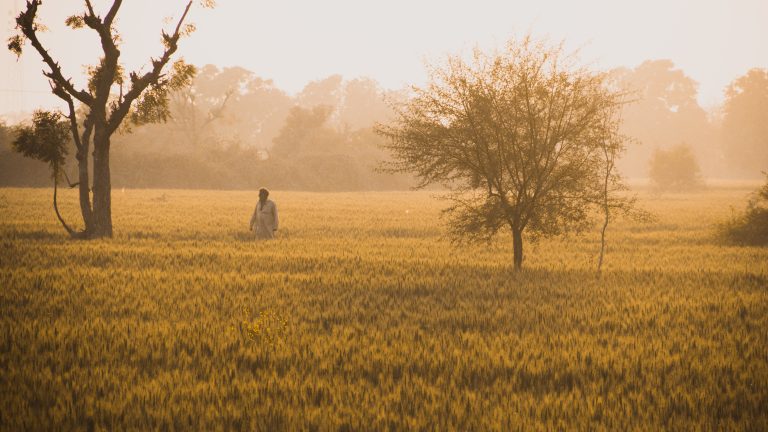
Climate-smart agriculture strategies for South Asia to address the challenges of climate change: Identification of climate-resilient agriculture practices for India, Bangladesh, and Afghanistan
Keywords
HIGHLIGHTS
- Climate change diminishes South Asia’s agricultural yields and nutritional quality.
- Climate-resilient solutions are being explored; some are in limited operation.
- Climate-smart farming strategies are classified as short-, medium-, or long-term.
- Key short-term strategies encompass zero tillage, crop diversification, and more.
- Widespread adoption of such strategies can empower farmers to tackle climate change.
1. INTRODUCTION
Food and nutrition pose significant challenges worldwide due to the expanding population, diminishing natural resource base, and farm management constraints. Food demands are increasing due to a growing global population and evolving dietary preferences. However, food production is struggling to keep pace due to declining crop yields, ocean degradation, and natural resource depletion (e.g., soil, water, and biodiversity). A 2020 report revealed that around 690 million people, accounting for 8.9% of the global population, experience hunger. Food security issues are expected to increase with the need to produce approximately 70% more food by 2050 to sustain an estimated population of 9 billion people (World Bank, 2020).
Agriculture provides avenues for sequestering carbon dioxide, but farming and allied practices and activities contribute to roughly 30% of ozone-depleting substance emissions, primarily from composts, synthetic pesticides, and animal waste. Climatic factors affect the accessibility and uptake of soil nutrients by plants, impacting the nutritional quality of food. For example, rising temperatures can affect growing season length, altering the annual and seasonal availability of nutrients.
Agricultural systems are extremely vulnerable to climate change due to their sensitivity to temperature and precipitation fluctuations and the occurrence of natural events and disasters. A recent study conducted by the World Bank across all six countries of South Asia suggested that climate change could significantly deteriorate living conditions for up to 800 million people in the region (Mani, Bandyopadhyay, Chonabayashi, Markandya, & Mosier, 2018). Furthermore, a report from the United Nations warns that advancing climate change could result in flooding, food shortages, and stagnant economic growth (Intergovernmental Panel for Climate Change [IPCC], 2014).
As of 2022, the IPCC reported that the mean global temperature had risen by 0.74 °C in the past century, with a projected further increase of 1.8–4 °C by 2100 (IPCC, 2022). Increased temperature and carbon dioxide levels adversely affect the nutritional quality of food. Elevated CO2 levels decrease the protein content and concentration of essential elements (N, P, K, Ca, Mg, S, Zn, Mn, Fe, and Cu) in food crops. These reductions can be mitigated through increased fertiliser application, though this poses affordability challenges in South Asian nations that heavily rely on fertiliser imports, and heightened fertiliser use can undermine agricultural sustainability. Based on the estimated global CO2 levels of 550 ppm by 2050, an estimated 175 million individuals will face zinc deficiency, and 122 million individuals will experience insufficient protein intake (Smith & Myers, 2018).
The United Nations’ Food and Agriculture Organisation recommended the adoption of climate-smart agriculture as a potential solution to combat adverse climate conditions in the South Asia region (Food and Agriculture Organization [FAO], 2015). A Philippines report on climate-smart agriculture suggests that combining multilevel, multi-actor, and participatory on-farm and off-farm actions is more effective in advancing climate-smart agriculture than solely relying on technical measures (Chandra & McNamara, 2018).
Identifying climate-resilient innovative technologies for farmer adoption is crucial for maintaining or increasing agricultural productivity despite the challenges posed by climate change. In pursuit of this, experts from Australia, India, Bangladesh, and Afghanistan collaborated in an Asia-Pacific Network for Global Change Research (APN) project to share experiences and educate farmers in climate-smart practices.
Through this APN-funded project, we endeavoured to learn and implement climate-smart agriculture technologies, making them accessible to grassroots farmers in the South Asia region. We aimed to establish a strong network with regional and global organisations and scientific bodies dedicated to addressing climate change-based challenges and developing sustainable agricultural practices. This would facilitate rapid dissemination of newly developed approaches to relevant farmers within a short timeframe. In this paper, we present a concise overview of the impact of climate change on agriculture in South Asia and identify climate-resilient farming technologies and practices for India, Bangladesh, and Afghanistan, drawing from expert experiences in these countries.
Within this context, climate-smart agriculture emerges as an approach that offers guidance for transforming agricultural and food systems towards environmentally friendly and climate-resilient practices. Its objectives align with achieving the Sustainable Development Goals through three core principles: (a) increase agricultural productivity to enhance incomes, ensure food security, and promote overall development; (b) enhance adaptive capacity across multiple levels, from individual farms to national systems; (c) reduce greenhouse gas emissions and promote the establishment of carbon sinks to mitigate climate change effects.
2. METHODOLOGY
We adopted a quantitative approach that combines and compares the findings from various studies to summarise the projected outcomes presented in the literature (scientific papers and unpublished reports) and gauge consensus. The experts identified technologies and practices that enhance crop resilience to climate change while minimising environmental impacts by sharing their local experiences at two workshops organised under the APN Project at Amity University in February 2020 and June 2022. The identified technologies were predicated on reported resilience impacts and farmer experiences. Country-specific technologies and practices used in the past 15 years were also identified through literature searches (e.g., Scopus, Google Scholar, CABI) and combing websites of national institutions to enhance the analysis.
3. RESULTS AND DISCUSSION
Different regions are experiencing different climate change change-relate-related impact of agriculture viz crop loss due to floods and drought, exacerbated heat, increased aridity, and greater impoverishment, leading to a loss of agro-biodiversity, increasing the vulnerability of pastoralists and the vulnerability to insect pests and diseases and, thus, resulting in lower yields and more erratic harvests etc. Figure 1 presents the broad impacts of climate change on crop plants. Country specific impacts and intervention for climate-resilient agriculture practices are discussed in following sub-sections.
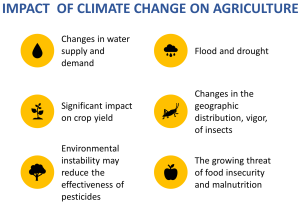
3.1. Impact of climate change on Australian agriculture
In Australia, temperatures above 34 °C from autumn to maturity have significantly impacted wheat grain quality and quantity (Asseng, Foster, & Turner, 2011). Western Australia has witnessed reduced average autumn and winter rainfall, increased prolonged droughts, elevated average temperatures and evaporation rates, and increased intense tropical cyclones compared to pre-1975.
Elevated CO2 levels favour wheat yields with temperature increases up to 2 °C but have detrimental impacts with further temperature increases (Bosco de Oliveira, 2019).
3.2. Impact of climate change on Indian agriculture
In India, a 1 °C increase in temperature will decrease annual wheat yields by 6 MT in Uttar Pradesh, Punjab, and Haryana states (Swaminathan & Kesavan, 2012). Projections indicate that the increasing temperatures could decrease the productivity of major crops by 10–40% by 2100. A 4 °C increase in developing nations could decrease their gross domestic product by 1–5%. Gas composition in India has increased by 0.5% for CO2 and 1% for methane in the last 269 years, reflecting the pressing reality of climate change (Table 1).
| Period | CO2 (PPM) | CH4 (PPM) | N2O (PPM) |
|---|---|---|---|
| Pre-independence (in 1750) | 280 | 715 | 270 |
| 2019 | 411 | 1774 | 319 |
| Increase (269 years) | @ 0.5% | @ 1% | @ 0.2% |
While elevated CO2 concentrations can increase crop yields, high fertiliser doses are detrimental to the environment. Elevated CO2 levels in India decreased protein, zinc, and manganese contents by 3–17% and grain yields by 2.6–232% (Loladze, 2002).
India witnessed ten droughts between 1870 and 1939, while the subsequent next 70 years (1940–2010) saw a 1.5-fold increase (15 droughts) in drought frequency (India Meteorological Department [IMD], n.d.).
The landscape of Indian agriculture has also witnessed shifts in the prevalence of insect pests and diseases that affect major crops. Pests like the leaf miner in tomato and groundnut, early blight in groundnut, and lab blight in tomato have emerged as significant challenges. Tomato bed, phytoplasma, and leaf curl viruses in tomato are also prevalent.
3.3. Impact of climate change on Bangladesh agriculture
Bangladesh faces a multifaceted impact from the changing climate, including rising ocean levels, saltwater intrusion, increasing mean temperature, fluctuating precipitation, and intensified winds (Bangladesh Bureau of Statistics, 2022). The country’s south, southwest, and southeast regions are particularly susceptible to extreme hurricanes and related saltwater intrusion. Recent increases in the mean temperature in October have hampered the growth of high-yielding Aman rice. The Bangladesh Bureau of Statistics (2022) predicts decreased production of various crops by 2050, including rice (5.3%), jute (3%), oilseeds (6.3%), vegetables (5.7%), wheat (6.4%), and pulses (0.45%). The changing Bangladesh climate manifests with hotter summers, irregular monsoons, increased river flow and denudation during monsoons, and concentrated heavy rainfall, resulting in waterlogging and crop damage due to flash floods. In the last 40 years, saltwater intrusion into Bangladesh’s flowing streams has notably intensified.
3.4. Impact of climate change on Afghanistan
Agriculture in Afghanistan is highly vulnerable to climate change. The ramifications are driven primarily by increasing temperatures, decreasing rainfall, water scarcity, early spring snow melts causing flooding, rapid depletion of urban underground water due to increased consumption, food and feed shortages, and rural–urban migration.
Afghanistan’s geographical location heightens its vulnerability to climate change, particularly drought, with an average annual rainfall of about 250 mm. Rainfed agriculture’s contribution to food security is declining due to low yields. Moreover, urban and industrial development are increasingly overtaking prime agricultural lands.
The FAO (2015) reports that the combined water storage capacity of Afghanistan’s five river basins and groundwater system is about 55 billion m3, and the current irrigated area is about 3.2 Mha. The Afghanistan Research and Evaluation [AREU] (2017) estimates this capacity is adequate for irrigating 7.7 Mha (at an average rate of 7,100 m3/ha). Nonetheless, mismanagement of water resources impedes the irrigation potential.
3.5. Interventions for climate-resilient agriculture
Climate-resilient technologies and practices, stratified across different crop stages, can be classified broadly as pre-production, production, post-harvest, and recycling (Table 2). Various climate-resilient technologies and approaches are being trialled, with some adopted on a limited scale, such as zero tillage, raised bed planting, direct-seeded rice, relay cropping, floating bed cultivation, Sorjan, stress-tolerant varieties, crop residue management, crop diversification (e.g., horticulture, beekeeping, mushroom cultivation), site-specific nutrient management, laser levelling, micro-irrigation, seed/fodder banks, and Information Communication TechnologyICT-based weather advisories (Kakraliya et al., 2021; World Bank Group, 2015). The specifics of these strategies vary across different climate change hotspots, as summarised in Table 3. Importantly, these technologies must be documented and validated at the farm level before scaling to broader geographic areas and benefiting more farmers.
| Pre-production | ● Soil health |
| ● Conservation agriculture | |
| ● Crop planning – right crop selection | |
| ● Crop calendar planning – change dates of sowing | |
| ● Stress resistant variety | |
| ● Dual land use | |
| Production | ● Water management |
| ● Pest management | |
| ● Nutrient management | |
| ● Agroforestry | |
| ● Ag-met advisory | |
| Post harvest | ● Pre-processing |
| ● Packaging | |
| ● Proper storage | |
| ● Proper transportation | |
| ● Value addition | |
| Recycling | ● Waste valorisation |
| Flood hotspot | 1. Flood tolerant crop cultivation |
| 2. Cultivation of submergence-tolerate rice varieties | |
| 3. Transplanting rice seedlings thickly in flood-free land and after flood water recession | |
| 4. Transplanting in the main field and transferring old seedlings from established crop fields to land from where flood water recedes lately | |
| 5. Producing fruits and vegetables in the homestead areas | |
| 6. Adjusting cropping calendar for avoiding flood | |
| 7. Sorjan cultivation | |
| 8. Floating bed cultivation | |
| 9. Rice-duck system | |
| Waterlogged hotspot | 1. Vegetable cultivation in floating beds |
| 2. Fruit and vegetables cultivation, following Kandi method | |
| 3. Cultivating aquatic vegetables | |
| Salinity hotspot | 1. Cultivation of salinity-tolerant rice varieties, salinity-resistant jute, peanut, sugarcane, kohlrabi, sweet potato, sesame, millet varieties, etc. |
| 2. Water harvesting technology appropriate for farm water management | |
| 3. Practising rice-fish-vegetables cultivation in the same land | |
| 4. Crop through ditch and dyke, sorjan system and raised bed, floating beds to avoid saline water flooding | |
| Heat stress | 1. Heat-tolerant varieties |
| Flash flood hotspot | 1. Adjusting cropping calendars for avoiding flash floods |
| 2. Short duration early varieties | |
| Drought hotspot | 1. Fruits and vegetables production in the homestead area |
| 2. Cultivation of low water-requiring crops like millets, maize, kaon, cowpea, etc. | |
| 3. Conservation of surface water by digging mini ponds at the corner of the crop fields | |
| 4. Using deep tillage and planting seedlings or sowing seeds at the deeper layer of the soil | |
| 5. Using mulch in fruits and vegetables cultivation | |
| 6. Relay cropping | |
| 7. Seed priming | |
| 8. Rain water harvesting | |
| 9. Watershed development |
3.5.1. Stress-tolerant/resistant varieties
The prevailing practice of cultivating local or high-yielding varieties leaves farmers susceptible to climate change shocks, often leading to poor productivity or even complete failure during extreme climatic events. Various national and international research institutes have developed stress-tolerant varieties for South Asian countries (see list in Table 4), which need to be validated and extended to vulnerable regions, enabling farmers to achieve reasonably good yields in the face of climate-induced stresses.
| Climate Hazard | Crop | Variety | Country |
|---|---|---|---|
| Salinity and Heat | Potato | BARI Alo-22 | Bangladesh |
| Sweet Potato | BARI Mishti Alo-8, BARI Mishti Alo 9 | ||
| Pulses | BARI Mug-2,3,4,5,6, BM-01, BM-08, BARI Falon-1, BARI Sola-9 | ||
| Oil Crops | BARI Sharisha-14, BARI Sharisha 15, BARI Chinabadam-9, BINA Chinabadam-1, BINA China badam-2, BARI Soyabean-6, BARI Til-2,3,4 | ||
| Sugarcane | ISWARDI-40 | ||
| Jute | HC-2, HC 95, CVL 1 | ||
| Rice | Kala Rata 1-24, Nona Bokra, Bhura Rata, SR 26B, Chin. 13, and 349 Jhona, CSR46, CSR49, CSR52, CSR56, CSR60 and CSR76 | India1 | |
| Sorghum | Raj 27, Raj 30, Raj 4, JS-2002, CSV-15, HC171 | ||
| Barley | Ratna, Melusine, RD 2794, ND B 1173, RD 2552, NDB 1173, NarendraBarley-1 (UP), NarendraBarley-3 (UP) | ||
| Oats | DZ-Cr-37, JHO-815, JHO-802, JHO-816 and UPO-201 | ||
| Wheat | KRL 1-4, KRL 19, KRL 210, KRL 213 | ||
| Jauhar, Gold, AAS, Ujala, Galaxy, Pasban, Uqab, Sehr | Pakistan | ||
| BARI Gom-26 | Bangladesh | ||
| Mustard | CS 52, CS 54 and CS 56 | India | |
| Drought-Tolerant | Rice | Sahabhagi Dhan, Vandana, Anjali, Satyabhama, DRR Dhan 42 (IR64 Drt 1), DRR Dhan 43, Birsa Vikas Dhan 203, Birsa Vikas Dhan 111, Rajendra Bhagwati, Jaldi Dhan 6 | India |
| Wheat | PBW 527, HI 1531, HI 8627, HD 2888, HPW 349, PBW 644, WH 1080, HD 3043, PBW 396, K 9465, K 8962, MP 3288, HD 4672, NIAW 1415, HD 2987 | India | |
| Dharabi, Ihsan, FSD-08, Khirman developed in Pakistan | Pakistan | ||
| Lalmi-2, Lalmi-1, Lalmi-3, Lalmi-4, Lalmi-15, PBW-154, Herat-99, Dehdadi-13, Zarin-13, Mirdad -19, Sharq-19, Jawahir-19, Lalmi-17, Dima-17, etc. | Afghanistan | ||
| Maize | Pusa Hybrid Makka 1, HM 4, Pusa Hybrid Makka 5, DHM 121, Buland, MIMH1 and MIMH2, Zodrus-10, Sharq-8, Shamal-8, Maghzi-8 | India | |
| Sorghum | CSH 19 R, CSV 18, CSH 15R | ||
| Pearl Millet | HHB 67 improved, GHB 757, GHB 719, Dhanshakti, HHB 234, Mandor Bajra Composite 2, HHB-226, RHB-177, Pusa Composite 443 | ||
| Barley | RD 2660, K603 | ||
| Chickpea | Vijay, Vikas, RSG 14, RSG 888, ICCV 10, Pusa 362, Vijay | ||
| Groundnut | Ajaya, Girnar 1, TAG-24, Kadiri 6, ICGV 91114 | ||
| Soybean | NRC 7, JS 95-60 | ||
| Sugarcane | Co 98014 (Karan-1), Co 0239, Co 0118, Co 0238, Co 06927, Co 0403, Co 86032 | ||
| Cotton | HD 324, CICR-1, Raj DH 7, Jawahar Tapti, Pratap Kapi, Suraj, Surabhi, Veena, AK 235, | ||
| Jute | JBO 1 (Sudhangsu), JRO 204, JRO 524, JRC 80 | ||
| Pulses | Bina masur-10 | Afghanistan | |
| Chickpea | Flib-95, Flip-92, Flip-93, Rabat-13, Baghlan-13 | ||
| Lentil | Koosk-1 | ||
| Pistachio | Pistacia vera, UCB1, | ||
| Watermelon | |||
| Muskmelon | |||
| Flood-Tolerant | Rice | Swarna Sub-1, Sambha Mahsuri Sub-1, Varshadhan, Gayatri, Sarla, Pooja, Prateeksha, Durga, JalaMani, CR Dhan 505, CR Dhan 502, Jalnidhi, Neerja, Jaladhi 1, Jaladhi 2, Hemavathi | India |
| Maize | PMH-2, TA-5084 HM-5, Seed Tech-2324, HM-10, PMH-2 | ||
| Sugarcane | Co 98014 (Karan-1), Co 0239, Co 0118, Co 0238, Co 0233, Co 05009 | ||
| Jute | JRO 7835, JRO 878, JRC 321, JRC 7447, JRC 532, JRC-517, Bidhan Pat-1 | ||
| Heat | Wheat | Jauhar, Gold, AAS, Ujala, Galaxy | Pakistan |
| BARI Gom-26 | Bangladesh | ||
| K1114, NIAW1994, DBW107, A-9-30-1, HD4502 (MALVIKA), GW2, GW 173, AKW 1071 (PURNA), PBN 51 (PARBHANI 51), K 9644 (ATAL), K 7903 (HALNA), WH 711, GW 322, RAJ 3777, MP 4010, K 9423 (UNNAT HALNA), UP 2565, MP 1142, DDK 1029 (dicoccum), MP 1202, RAJ 4079, K0402, DBW 107, DBW 173 | India | ||
| Lalmi-2, Lalmi-1, Lalmi-3, PBW-154, Herat-99, Dehdadi-13, Zarin-13, Mirdad-19, Sharq-19, etc. | Afghanistan | ||
| Rice | NERICA-L-44 | India | |
| Potato | KUFRI LIMA | ||
| Maize | YH-1898, KJ Surabhi, FH-793 ND-6339, NK-64017 | ||
| BHM14, BHM15 | Bangladesh | ||
| RCRMH2, Lall-454, Zodrus-10, Sharq-8, Shamal-8, hybrid-1, hybrid-2, hybrid-3 | |||
| Rampur Hybrid-8, Rampur Hybrid-10 | |||
| Cold and frost | Maize | HQPM-1, HHM-1, and HM-1 | |
| 1Source: https://icar-nrri.in/released-varieties/, www.nicra-icar.in/nicrarevised/images/publications/Climate Resilent Crop_All Pages_12-03-19_low.pdf | |||
3.5.2. Grafting plants to build stress tolerance
Climate change has exacerbated abiotic stresses in vegetable production, posing threats from flooding, drought, and extreme temperatures. Vegetable grafting has emerged as an eco-friendly, expedient, and efficient technique for producing climate-resilient plants that can withstand these abiotic pressures (Singh, Sethi, Kaushik, & Fulford, 2020).
3.5.3. Climate-resilient cultivation practices
Replacing existing crops with new climate-resilient alternatives is an emerging strategy for combating climate change. For example, in wind-prone areas of India, some farmers grow millets (e.g., pearl millet) and sorghum. They also integrate leguminous crops to enhance soil nitrogen and preserve fallow land (Satapathy, Porsche, Kunkel, Manasfi, & Kalisch, 2011). Shifting the timelines for wheat sowing and rice transplantation to 15 days earlier than conventional practices could mitigate yield losses by more than 4% (Jat et al., 2014).
3.5.4. Soil health management
The vitality of soil health in evolving environments is paramount to crop production. Notably, soil health extends beyond agriculture, with its status as an indicator of human well-being (Lal, 2022). Strategies to enhance soil health include building soil carbon, controlling soil losses due to erosion, and increasing soil water-holding capacity. Embracing practices like conservation agriculture or zero tillage, soil mulching, crop rotations involving legumes, soil microbiome management, soil nutrient management, soil-borne pest and disease management, soil moisture management, agroforestry, and integrated farming systems are pivotal in enhancing soil health and building crop resilience to climate change.
An Australian study reported that annual wheat production could increase by 1.1 to 1.2 billion AUD by improving soil conditions (Linehan, Thorpe, Andrews, & Beaini, 2012). As the largest carbon pool on Earth, soil plays a crucial role in global carbon and nutrient cycling. Enhancing soil carbon storage and sequestration is essential for improving soil quality, fortifying plant nutrition reservoirs, and increasing crop productivity amidst ongoing and upcoming climate change impacts. Furthermore, soil carbon sequestration can help mitigate adverse climatic effects, including increased surface and soil temperatures, elevated CO2 levels, and fluctuating precipitation patterns.
The most effective strategy for accumulating and sequestering soil organic carbon lies in prudent management practices that stimulate soil carbon inputs (e.g., plant residues) rather than outputs (e.g., decomposition and leaching). Achieving a balanced and integrated use of fertilisers (organic and inorganic) presents an alternative approach to enhancing soil carbon sequestration, preserving plant nutrients, and increasing productivity.
Below are some instrumental farming practices for managing soil health.
Conservation agriculture: Significance of zero tillage
Zero tillage is becoming a cornerstone of conservation agriculture and climate-smart farming (Figure 2). Two main principles underpin zero tillage:
- Minimum soil disturbance
- Stubble retention in fields
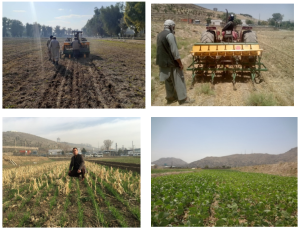
Zero tillage offers numerous advantages, such as:
- Enhanced soil structure
- Improved nutrient recycling
- Increased crop yields
- Time-saving attributes
- Feasibility for early sowing
- Reduced soil erosion
- Reduced pollution arising from stubble burning or soil erosion
- Improved soil water-holding capacity
- Provision for grazing, if required
Data from long-term (25 years) zero-tillage experiments conducted in Australia, Mexico, Brazil, Spain, the UK, and the USA have revealed incremental yield with zero tillage over time. In Western Australia, the adoption rate of zero tillage among farmers stands at a remarkable 100% (Ward & Siddique, 2015). In India, farmers often burn crop residues for disease and weed control. However, zero-tillage systems are promoted to minimise stubble burning, and farmers can hire zero-tillage seeders for sowing. Various zero-tillage seeders are available across different countries. Recently, the Indian Agriculture Research Institute developed technology involving a consortium of microorganisms for in-situ stubble decomposition (Maheshwari, Mahapatra, Bharti, & Singh, 2020).
Mulching
Mulching materials (e.g., straw, gravel sand, plastics) are another effective tool for soil management, weed management, and soil water conservation.
Intercropping and relay cropping
Intercropping, the practice of cultivating multiple crops simultaneously in a field (Figure 3), offers resource optimisation and enhanced land productivity, increasing system productivity. For example, system productivity increased by 19% under soybean and pigeon pea (4:2 ratio), 25% under pearl millet and pigeon pea (3:3), 25% under Bt cotton and green gram (1:1), 14% under Bt cotton and black gram (1:1), and 24% under Bt cotton and pigeon pea (5:1) (Prasad et al., 2014). As another climate-resilient crop diversification, tree-based farming systems also benefit farmers due to the high value of horticultural products.
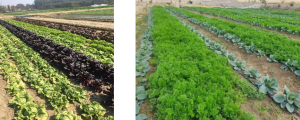
3.5.5. Direct-seeded rice
Direct-seeded rice (DSR) technology conserves water resources by up to 50% as it does not require flooding, with pregerminated rice seeds sown in puddled soil. This technique also reduces the carbon footprint of rice by reducing methane emissions. Irrigation is applied during crucial crop growth stages, such as crop emergence (first 7–15 days after sowing). DSR requires efficient weed management to prevent yield losses.
3.5.6. Leaf-colour-based nitrogen application
IRRI developed a leaf colour chart (LLC) for nitrogen application in rice (Figure 4; MSME MART, n.d.). Reports indicate nitrogen savings of up to 40% (Satpute, Surje, & Maity, 2014).
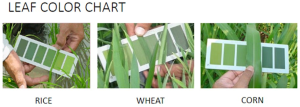
3.5.7. Water management
Water availability is a critical determinant of crop yield, with efficient water use particularly important in changing environments. For example, the water use efficiency of wheat is impacted by delayed sowing, weed proliferation, waterlogging, and nematode infection (Figure 5; French & Shultz, 1984 cited in Sadras 2020).
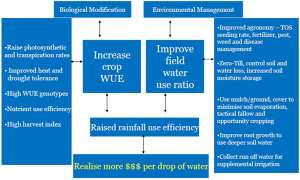
Integrated water management, encompassing various water-saving practices and technologies, can save between 22% and 84% of water. Practices such as the system of rice intensification (SRI), DSR, relay cropping, use of waste and marginal water, laser levelling, mulching, and conservation agriculture have demonstrated water savings ranging from 22% to 43% in various crops (Jat et al., 2014). Adopting micro-irrigation systems, such as drip and sprinkler, can yield additional savings of up to 84% (Kumar, 2016).
Several water management practices conducive to adapting rice cultivation to climate change have been identified (Aryal et al., 2020):
- Alternate wetting and drying enhances water use efficiency by 30%.
- DSR improves water use efficiency and water stress resilience.
- Micro-irrigation system (sprinkler and drip) saves up to 90% water.
- Laser land levelling contributes up to 30% water savings.
Sorjan system
The Sorjan system, originating from Indonesia, features very high raised beds alternated with deep sinks, suitable for water flooding and dry systems. In the Philippines, a 1 ha Sorjan farm generated an additional Php 75,000 (1329.75 USD) in 12 months from diverse vegetables like okra, eggplant, string beans, cucumber, and tomato (Philippines Rice Research Institute [PRRI], 2017). This farming approach fosters sustainable earnings, with rice cultivation an integral component.
Floating bed cultivation
Floating bed cultivation is particularly advantageous for areas prone to extended periods of submersion (UN Climate Technology Centre and Network [UNCTCN], n.d.), as observed widely in Bangladesh. The floating beds are constructed from various substrates, such as crop residues, water hyacinth, and straw, secured with ropes atop a bamboo base (Figure 6). After harvest, the floating beds can be composted and reintroduced into the same field as a nutrient source.
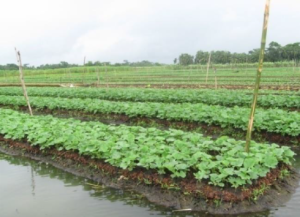
Relay cropping
Relay cropping is a multiple cropping system where a subsequent crop is sown into a standing crop before it is harvested. This method addresses challenges related to resource utilisation, sowing time, fertiliser application, and soil degradation (Figure 7). Relay cropping is a sophisticated toolkit for enhancing soil quality, increasing net returns, increasing the land equivalent ratio, and managing weed and pest infestations.
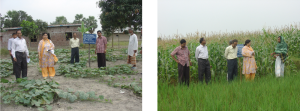
For instance, corn (grown for seed) and soybean are suitable for relay cropping as seed corn is harvested in mid-September, leaving moderate residues. Annual winter crops, such as winter wheat, could be added to the seed corn–soybean rotation to use solar energy and heat device accessible during corn harvest in September and soybean planting in May. However, winter wheat is not harvested till mid-July, much later than the prime time for soybean planting. Relay cropping in Nebraska requires middle-pivot irrigation, glyphosate-tolerant soybean, and a method of seeding soybeans into wheat at heading (approximately 30 days before wheat harvest).
The advantages of relay cropping include:
- Decreased nitrate leaching
- Increased carbon sequestration
- Increased farmer income
Some examples:
- For small grain crops as the first planting and legumes as the second, legumes can be seeded into small grain crops well before it is harvested.
- For rice as the first planting and legumes as the second, seeding of the legume crop can be done by aerial broadcast before harvesting of rice crop so as legume crop is established and utilises residual mixture to germinate and establish before the rice crop is harvested.
- For maize, sorghum, or millet as the first planting and soybean or legumes as the second, the second crop can be banded between rows of the first crop well before its harvesting.
3.5.8. Protected cultivation
Protected or greenhouse cultivation represents an advanced approach to growing crops in an optimal environment, shielded from abiotic (e.g., temperature, rain, wind, humidity) and biotic (plant pests and diseases) stressors. This method enables farmers to grow crops on demand, irrespective of the traditional growing seasons (Figures 8–11), resulting in higher yields using 90% less water and fewer nutrients.
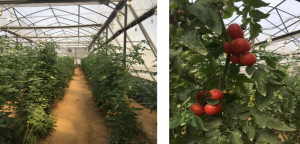
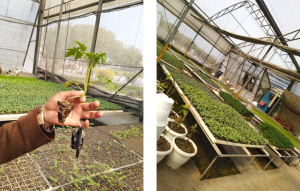
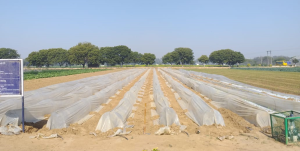
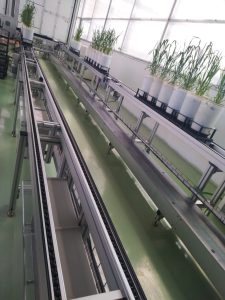
Various types of structures are used in protected cultivation:
- Climate-controlled greenhouses are sizeable structures incorporating transparent or translucent material, offering an ideal environment for crops to thrive under optimal conditions. Suitable for high-value crops such as vegetables and flowers.
- Zero-energy, naturally ventilated greenhouses are simple yet effective blanketed structures with no heating or cooling devices. They rely on natural ventilation through pest-proof netting, mainly on the top and the sides. These medium-value greenhouses are supplemented with manually operated natural air flow devices. Suitable for growing cucumber, tomato, and capsicum for 8–9 months each year.
- Shade net houses are used during critical summer months (May–September), reducing the sunlight intensity by 25–75% to decrease radiation and temperature to a certain threshold. Suited to areas where night temperatures do not drop below 15–18 °C and daytime temperatures are generally 28–30 °C.
- Insect-proof net houses are reasonably priced, temporary or lasting structures clad with 40–50 µm mesh UV-stabilised insect-proof nylon or rust-proof metal net These structures prevent the access of dangerous insect-pest and vectors of illnesses, reducing the need for pesticides in fresh vegetable cultivation.
- Walk-in tunnels are temporary constructs crafted from materials such as galvanized iron (GI) pipes, plastic pipes, or semi-spherical bent bamboo clad with UV-stabilised (150–200 µm) polyethylene. The central top is retained to 6–6.5 ft. and 4.0–4.5 ft wide. The tunnel length varies according to need. These tunnels are designed to be easily assembled and disassembled using nuts and bolts (no welding required). They can bear trellis loads of 15–25 kg/m2.
3.5.9. Zero-energy cooling chambers
Zero-energy cooling chambers (ZECC) work on evaporative cooling principles, i.e., temperatures decrease due to liquid evaporation. Each chamber is an aboveground double-walled brick structure with a 7.5 cm wide cavity packed with river sand. The top of the structure is covered with gunny fabric filled with straw in a bamboo structure. The cool chamber is soaked with water initially and thereafter sprinkled with water in the morning and evening to preserve the specified temperature and humidity (Figures 12 and 13). These chambers can hold excessive humidity (95%) throughout the year and even reduce the chamber temperature during summer. ZECCs are best used for short-term produce storage and are particularly beneficial for marginal farmers needing short-term storage solutions (Kitinoja, Saran, Roy, & Kader, 2011; Mishra, Jha, & Ojha, 2020).
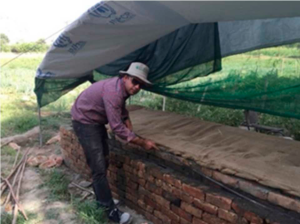
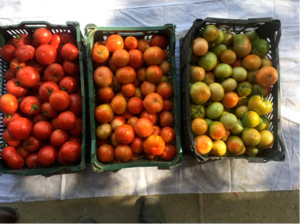
3.5.10. Broad bed and furrow
In the broad bed and furrow (BBF) system, a machine is used to create 90 cm wide beds and 45 cm wide furrows, maintaining a 30 cm row spacing (Figure 14). BBFs conserve rainwater in-situ in furrows, allowing for excess water drainage, proper aeration, and weed control.
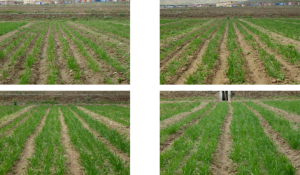
3.5.11. Crop pest and disease management
Crop pest and disease management are critical as many pests and diseases have shifted their geographical boundaries due to the changes in temperature and humidity, creating favourable conditions for their migration. Crop pests and diseases are projected to extend to higher altitudes. Projected global yield losses for three staple grain crops (rice, wheat, and maize) due to insect pests are 10–25% per 1 °C increase in global mean surface warming, with such losses more acute in temperate regions (Deutsch et al., 2018). Governments in South Asian countries focus on integrated pest management strategies and farmer training to handle the growing emergence of pests and diseases. Insect and disease forecasting models have been developed for their timely management. Innovative techniques, such as pheromones, push–pull, microbial seed inoculants, and resistant varieties, also aid in pest and disease control.
3.5.12. Climate-smart future foods
Given the impact of climate change on traditional staple crops like wheat and rice, scientists have started advocating for the cultivation of climate-resilient local grains such as millets, which can withstand most abiotic stresses and are nutritionally dense (Reay, 2019). An FAO study identified numerous Future Smart Foods (FSF) for South and South-East Asia, prioritising 39 FSFs such as sorghum, pearl millet, elephant foot yam, roselle, drumstick, Amla, lentil, jackfruit, and fenugreek (Li & Siddique, 2018).
3.6. Climate-resilient actions in India, Bangladesh, and Afghanistan
Climate-resilient practices identified for various hotspots in South Asian countries include:
- Flood-prone areas:
- Tomato seedling grafting on the rootstock of brinjal for flood and wind tolerance
- Aged seedlings
- Dense transplantation of seedlings in flood-free areas and later transferred to flooded areas after water levels recede
- Forest nuts and pistachio trees in hilly flood-prone areas
- Fast-growing crops, such as vegetables, millets, and maize, to avoid floods
- Flood-resistant rice varieties
- Waterlogged areas:
- Float bed cultivation
- Aquatic vegetables
- Flood-tolerant varieties
- Drought-prone areas:
- Harvest rainwater using various techniques (Figure 15)
- Sow early or late to escape drought
- Use soil moisture by sowing seeds at depth
- Soil mulches for soil moisture conservation and to avoid weeds
- Drought-tolerant/resistant varieties
- Saline-prone areas:
- Saline-tolerant crop varieties
- Sorjan systems such as dykes/raised beds
- Vegetables around prawn Ghers or ponds
- Rice–duck or rice–fish–vegetable cultivation to enhance income
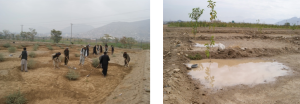
3.7. Initiatives in India
The Indian Government is taking proactive steps to showcase climate-resilient practices and technologies in 151 clusters located within districts highly vulnerable to adverse conditions like droughts, heatwaves, floods, salinity, high temperatures, cold waves, erratic rainfall, and cyclones.
Numerous climate-smart practices are being promoted in India:
- Climate-resilient varieties
- Broad bed furrow for sowing vegetables
- Intercropping with varying row ratios
- Conservation agriculture
- Soil health management
- Identifying climate-smart future foods
- IT-based mobile app PESTPREDICT-EMS, an Android-based app developed by the Indian Government to help farmers identify pests
- Seaweed farming, multitrophic aquaculture, and recirculatory aquaculture to combat climate change related to livelihood security issues
- District agriculture contingency plans developed with local departments to prepare farmers to face climatic risks more efficiently
4. CONCLUSION
The undeniable reality of climate change compels us to act, using existing solutions and developing new options for the well-being of future generations. While drawing insights from a specific group of experts representing certain countries, this study acknowledges the potential exclusion of certain technologies due to its scope.
Key action points include:
- Forecasting extreme events: Anticipating and preparing for extreme climatic events becomes crucial for the future, necessitating proactive strategies.
- Balancing yield and environmental impact: Striking a balance between increased yields and reduced ecological footprint becomes pivotal for preserving soil health, environmental sustainability, and socio-economic well-being.
- Crop rotation for soil health: Implementing cereal–legume crop rotations will enhance soil health and mitigate the environmental impact of fertilisers.
- Technology transfer and farmer awareness: Facilitate technology transfer through practical demonstrations, field visits, field training, and field days. Improve farmer awareness of the cost-benefit analysis to help drive successful adoption.
- Enhancing zero-tillage systems: Successful zero-tillage systems must emphasise cultural practices, including proper sanitation (e.g., cleaning equipment to remove old seeds and weed seeds), accurate seeding depth, starter fertilisers, high-quality seeds, and seedling vigour to avoid crop competition.
By implementing climate-smart agriculture, enhancing food security becomes feasible. This involves increasing crop productivity while minimising the risk of crop failure, thereby mitigating the adverse impacts of climate change on agriculture.
As the study scope is limited, evaluating the applicability of the suggested technologies/practices across broader geographical contexts is necessary. The effectiveness of the examined technologies may also be influenced by climatic variations, underscoring the importance of local testing before wider adoption.
5. ACKNOWLEDGEMENTS
We gratefully acknowledge the support received from ICAR, Sardar Ballabh Bhai Patel University, Meerut; KVK, Gautam Buddha Nagar, KVK, Muzaffarnagar; KVK, Ghaziabad, and KVK Ujjwa for providing support to organise farmer training programmes in India and participating in the master training workshop. We further acknowledge the support received from all the speakers at the Trainer workshop and for sharing their experiences. Support received from the project partners is gratefully acknowledged. We are grateful to APN for providing financial support under Grant No. CBA2019-03MY-Kaushik, and to the officials, colleagues, and staff at Amity University for their support in implementing this project.